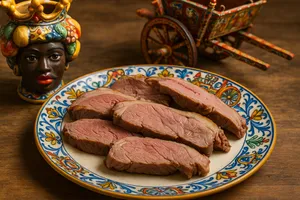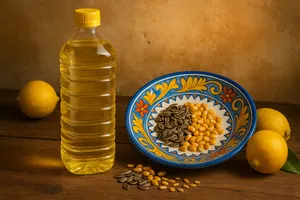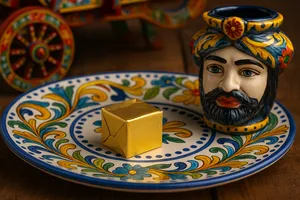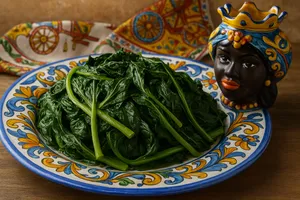Overview
Coffee is far more than a simple beverage on the island: it is a daily ritual, a social moment, and an important ingredient in traditional pastry. Introduced to Sicily in the early 18th century, coffee quickly found a second home there, becoming deeply woven into the island’s culinary culture and inspiring unique preparations blending the Arab tradition of sweets with the intense aroma of this drink.
In Sicilian cafés, coffee is the protagonist of a ritual repeated several times a day: the espresso at the counter—quick but never rushed—often accompanied by a brioche or a glass of water. In pastry-making, coffee enriches creams, gelati, granite and classic desserts, adding its unmistakable aroma and enhancing both chocolate and nut-based flavours.
Characteristics
Coffee comes in several forms: whole beans, ground coffee, and instant coffee. Raw coffee beans are greenish, while roasted beans range from light to dark brown depending on the roast level. Ground coffee releases an intense fragrance with aromas ranging from fruity to toasted, chocolatey to spicy.
Its flavour is complex: bitterness from caffeine, acidity that varies by origin and roast, and a body that can be light or full. Italian espresso—especially beloved in Sicily—is known for its dense, persistent crema, deep brown colour, and penetrating aroma.
The quality depends on many factors: bean origin, variety (Arabica or Robusta), roast level, grind freshness and brewing method.
Varieties
Arabica
Considered the most refined variety, grown at high altitudes, Arabica has a delicate, aromatic flavour with mild acidity and lower caffeine content. It is highly valued for quality espresso.
Robusta
More resistant and productive, grown at lower altitudes. It has a stronger, more bitter taste, higher caffeine content, and produces a thicker crema. Often blended with Arabica to balance flavour and body.
Use in pastry
Coffee is a versatile and beloved ingredient in Sicilian pastry.
Coffee granita
A Sicilian classic made with sweetened espresso churned into a smooth, semi-frozen texture, served with whipped cream. It is the ultimate summer breakfast, traditionally accompanied by brioche col tuppo.
Coffee gelato
Sicilian coffee gelato uses concentrated espresso, giving it a deep, authentic flavour, often enriched with cream for smoothness.
Coffee cream
Used to fill cannoli, cassate and cakes, prepared with egg yolks, sugar, milk and espresso. The result is a velvety cream with a bold taste, also ideal for tiramisù, now widely adopted in Sicilian pastry.
Coffee biscuits
Many traditional Sicilian biscuits are coffee-flavoured, from dunking cookies to almond cookies enriched with espresso, combining almond sweetness with coffee intensity.
Flavouring
Coffee enhances creams, batters, glazes and chocolate ganache. Just a few drops of ristretto intensify chocolate desserts such as brownies, cakes and mousses.
Coffee in Sicilian tradition
Coffee with lemon zest
A typically Sicilian custom: espresso served with a strip of lemon zest rubbed on the rim of the cup to release essential oils, adding a citrus note.
Caffè d'a fuitina
A romantic name for coffee served boiling hot in a glass cup, meant to be drunk quickly—just as lovers who eloped (“fuitina”) would do before running off.
Coffee with cream and cinnamon
A winter speciality in mountain areas, where coffee is topped with whipped cream and a dusting of cinnamon.
Making the perfect espresso
For high-quality espresso—fundamental in Sicilian tradition—use about 7 grams of finely ground coffee per shot. Water should be 90–95°C, with 9 bars of pressure. Extraction should last 25–30 seconds, producing about 25–30 ml of espresso.
Grind size is crucial: too fine yields bitter, burnt coffee; too coarse gives watery coffee. Ground coffee loses aroma quickly, so it is best freshly ground or stored in airtight containers.
Nutritional properties
Unsweetened espresso contains just 2–3 calories per cup and is virtually free of fat and protein. It is rich in caffeine, a natural stimulant that boosts alertness and reduces fatigue. A single espresso contains about 40–80 mg of caffeine depending on bean and preparation.
Coffee is a significant source of antioxidants—especially chlorogenic acids and polyphenols—associated with cardiovascular and metabolic benefits. It also contains small amounts of B vitamins, potassium and magnesium.
Moderate consumption (3–4 cups daily) is considered safe for most people and may be beneficial. Excessive intake can cause nervousness, insomnia or rapid heartbeat.
Storage
Whole beans keep better and longer than ground coffee. They should be stored in airtight containers, away from heat, light and moisture, ideally in a cool, dry place. Roasted beans keep their best qualities for about a month.
Ground coffee loses volatile aromas quickly and should be consumed within a week, stored airtight. Never store it in the refrigerator—coffee absorbs odours and humidity damages quality.
Vacuum-packed coffee lasts longer, but once opened should be used promptly. Coffee can be frozen in small sealed portions and keeps well for 2–3 months.
Buying tips
Check the roasting date: the more recent, the better. Buying whole beans and grinding them just before brewing ensures freshness.
Choose Arabica or blends based on preference: Arabica offers more aromatic complexity, while Robusta adds body and crema—common in Sicilian and Neapolitan-style espresso.
Artisanal roasters generally offer fresher, higher-quality coffee than industrial long-shelf-life products. Read labels for origin, blend composition and roast level.
Curiosities
Palermo’s first public café opened in 1763: the famous “Caffè del Cassaro” (now Corso Vittorio Emanuele), soon a meeting place for aristocrats and intellectuals. Historic cafés were hubs of political debate and cultural exchange.
In Messina, a unique tradition persists: “cafè siccu e chiamatu”, meaning unsweetened coffee served with a glass of water to someone who arrives without notice. Once a subtle hint that the visit was unwelcome, today it is simply the classic way to serve espresso.
Coffee granita with cream was created in 19th-century Messina and later spread across Sicily. Tradition dictates that the cream should not be mixed in, but enjoyed in alternating spoonfuls with the granita.
Many Sicilian cafés still serve “caffè in ghiaccio”, made by pouring hot espresso over crushed ice, sweetened and sometimes flavoured with almond milk—an easier alternative to granita.
Coffee has inspired Sicilian sayings such as: “U cafè è comu l’amuri, s’av’a pigghiari caudu” (“Coffee is like love, it must be taken hot”), or “Dopu manciatu, cafè e passiata” (“After eating, coffee and a walk”), capturing its central role in island life.











